7. Google Now and Navigation
In this chapter, you find out how to use Google Maps, Navigation, and Google Now. Topics include the following:
→ Staying up to date with Google Now
→ Taking map data offline
You can use your Android phone as a GPS navigation device while you walk or drive around. Your phone also includes an app called Google Now that provides all the information you need when you need it.
Using Google Now
You can access Google Now from the Lock screen or from any screen, which enables you to search the Internet. Google Now provides you with information such as how long it takes to drive to work and the scores from your favorite teams.
You can access Google Now from any app or the Home screen pane by swiping from the bottom of the screen up onto the screen and toward the word Google. If you are on the Home screen, you can also swipe all the way to the left to see Google Now. It is the leftmost Home screen pane.

Use Google Now
After you access Google Now, you can see current information, or search the Internet.
1. Cards automatically appear based on your settings. Examples of these cards are scores for the sports teams you follow, upcoming meetings, weather in the location where you work, and traffic on the way to work.
2. Tap the Microphone icon to speak a search term or to command Google Now to do something. You can also type your search terms.

3. Information relevant to your search appears.
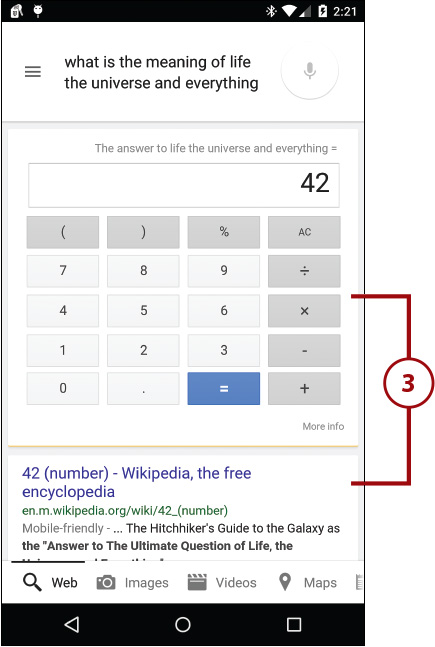
In addition to searching the Internet using Google Now, you can command Google Now to do things for you. For example, you can tell Google Now to set an alarm for you, compose a text message, or even send an email. This is just a small list of the types of things you can have Google Now do for you. To see a comprehensive list of commands, visit http://trendblog.net/list-of-google-now-voice-commands-infographic/.

Set Up Google Now
For Google Now to work for you, you need to set it up correctly. This also means sharing your location information with Google.
1. Swipe in from the left side of the screen to reveal the menu.
2. Tap to add and manage reminders. After adding a reminder, Google Now notifies you of the activity when the reminder is due.
3. Tap Customize to customize what kinds of Google Now cards are displayed. This includes choosing sports teams, stocks, places, and TV and video.
4. Tap Settings.

5. Tap to manage what Google Now can search for. This can include apps you have installed, bookmarks and web history in the Chrome web browser, your contacts, Google Play Books, Movies & TV, and Music.
6. Tap Voice to manage how and when Google Now responds to your voice.

7. Tap to choose the languages that Google Now responds to.
8. Tap to choose when Google Now should be listening for you to say “OK Google,” which is the key phrase that launches Google Now. You can choose to have Google Now listening only from the Google Now app, from any screen, or from the Lock screen.
9. Tap to choose whether Google Now works when your phone is locked, and how it should listen for your commands. You can choose to let Google Now use a paired Bluetooth device, a headset connected by a cable, or both.
10. Tap to choose when Google Now speaks back to you. Your choices are On (which means always), Off (which means never), or only when you are using a hands-free device (such as a Bluetooth headset or your car’s built-in Bluetooth connection). Some phones may not include the “Off” choice here.
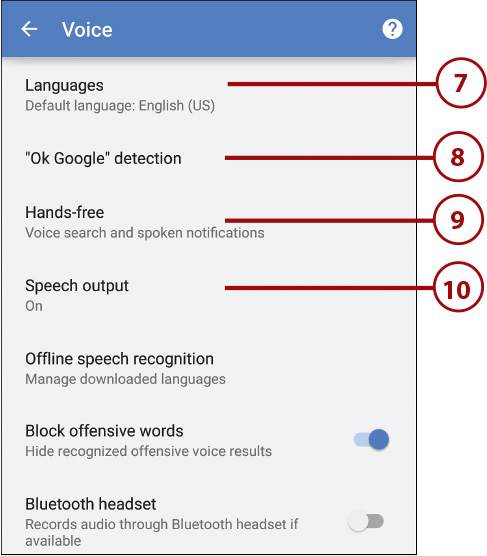
Beware of Others Speaking to Your Phone
Be careful about deciding when Google Now can listen for commands. If you allow Google Now to listen for “OK Google” on any screen (which means on any screen plus while running any app), the only drawback could be battery life suffering, but if you let Google Now listen for “OK Google” from the Lock screen, there is the potential for someone else to instruct your phone to do things. Even though when you enable this feature, you are asked to say “OK Google” three times so that Google Now can become familiar with your voice, it is possible for others to command your phone to send emails, read emails back to them, and so on.
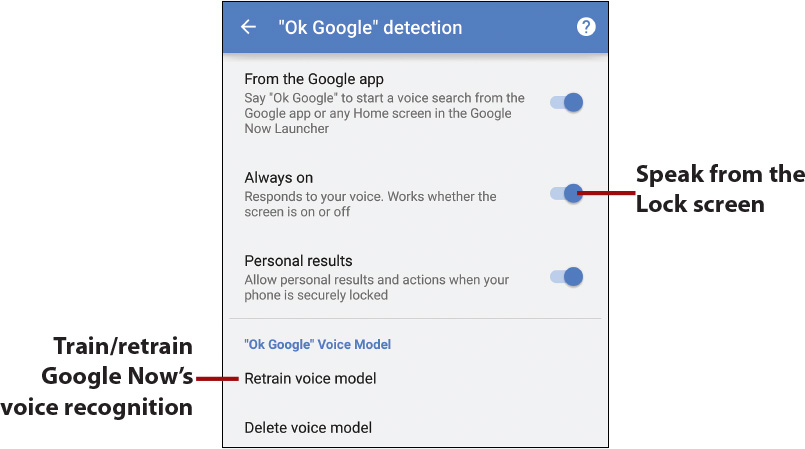
11. Tap to manage whether Google Now speech recognition can work even when there is no Internet connection. This is achieved by downloading one or more languages to your phone.
12. Tap to block offensive words being spoken when search results are returned by voice.
13. Tap to allow Google Now to record your voice using your Bluetooth headset or built-in car Bluetooth.
14. Tap to save your changes and return to the main Google Now Settings screen.


16. Tap to choose which of your Google accounts (if you have more than one) you want to use for Google Now.
17. Tap to manage whether apps can share your data with Google and clear any data that apps on your phone have shared with Google.
18. Tap to enable or disable the SafeSearch Filter that blocks offensive content.
19. Tap to choose whether you want to share your commute status, such as when you leave for home or leave for work. People need to be in your Google+ Circles to receive your Commute updates.
20. Tap to enable or disable high-contrast text if you have a vision disability.
21. Tap to enable or disable Google Now sending Google information on how you use Google Now.
22. Tap to save your changes and return to the main Google Now Settings screen.
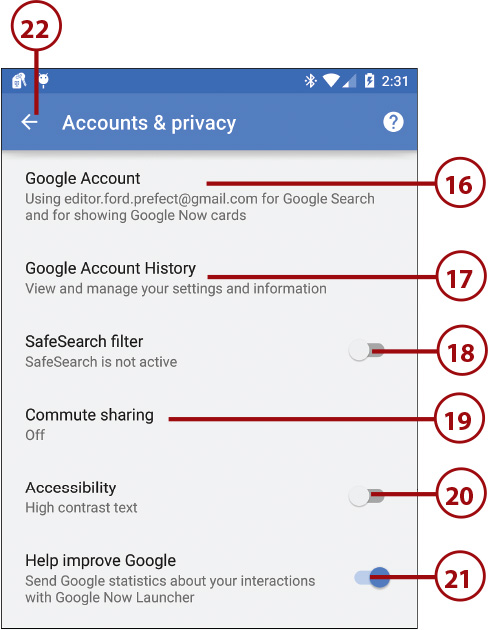
23. Tap to manage how Google Now alerts you when new cards are ready, and choose the ringtone that plays when they are ready to view.
24. Tap to save your changes and return to Google Now.
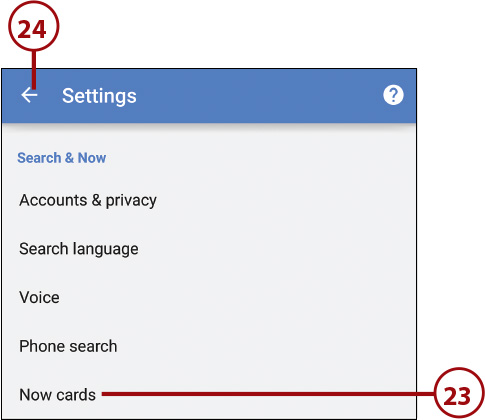
Telling Google Maps Where You Live and Work
Google Now can be even more effective if you configure your work and home addresses in Google Maps. Google Now uses that information to tell you things like how long your commute to work will be, whether there is heavy traffic on the route, and so on. See step 3 in the “Configure Google Maps Settings” task later in this chapter on how to do that.
Navigating with Google Maps
Google Maps enables you to see where you are on a map, find points of interest close to you, get driving or walking directions, and review extra layers of information, such as a Satellite view.
1. Tap to launch Google Maps.
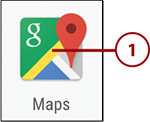
2. Tap to type a search term, the name of a business, or an address.
3. Tap to speak a search term, the name of a business, or an address.
4. Tap to get walking or driving directions from one location to another. You can also choose to use public transit or biking paths to get to your destination.
5. Tap to switch between the top-down view that always points North, and the 3D view that follows the direction your phone is pointing.
6. Tap to explore what’s around your current location.
7. Swipe in from the left of the screen to reveal the menu.
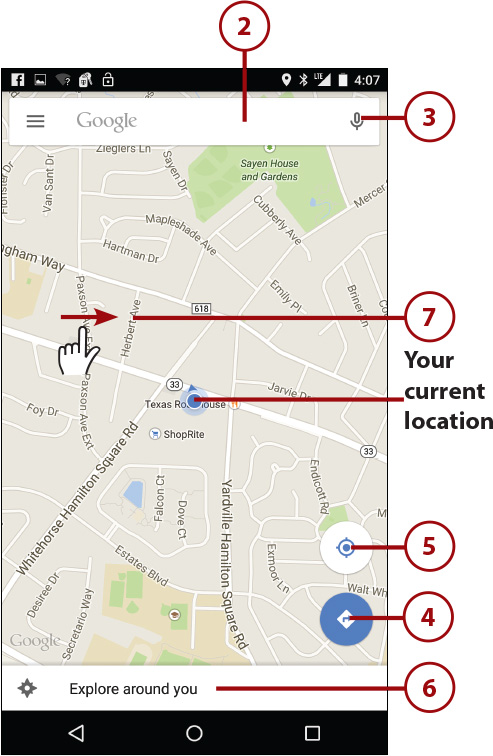
When you tap Explore Around You, you are presented with restaurants and businesses within a 20-minute drive and a time of day. The time of day should be the current time of day (for example, “Morning”) and that determines the search criteria for restaurants. For example, if it’s morning, the screen will show nearby restaurants that serve breakfast. Where possible, a star rating is provided for each restaurant so you can quickly see if it is rated highly. Tapping on a restaurant or business shows more information about it, including the address, hours of operation, the menu (if available), and the ability to quickly get directions. You can also tap the star icon to save the restaurant to your favorites, and in the future the restaurant will be displayed with a star on the map.
8. Tap to switch to a different Google account for use with Google Maps.
9. Tap to see your work and home address, plus addresses you have recently searched for, and any places you have saved to your favorites.
10. Tap to toggle between the Map view and the Satellite view.
11. Tap to show the current traffic conditions on the Map view or Satellite view.
12. Tap to show all public transport locations on the Map view or Satellite view.
13. Tap to show all bicycling routes on the Map view or Satellite view.
14. Tap to see the Terrain view.
15. Tap to launch the Google Earth app.
16. Tap to change the settings for Google Maps.

Changing Google Maps Settings
See the “Configure Google Maps Settings” task later in this chapter for more information about customizing Google Maps.
1. Tap the Directions icon.

2. Tap to set the starting point or leave it as Your Location (which is where you are now).
3. Tap to flip the start and end points.
4. Tap to use driving directions.
5. Tap to use public transportation.
Using Public Transportation
If you choose to use public transportation to get to your destination, you have two extra options to use. You can choose the type of public transportation to use, including bus, subway, train, or tram/light rail. You can also choose the best route (fewer transfers and less walking).
6. Tap to walk to your destination.
7. Tap to use bike paths (if available).
8. Tap to choose a previous destination. If you need to type the address of your destination, skip to step 9; if not, skip to step 10.
9. Type or speak the destination address.
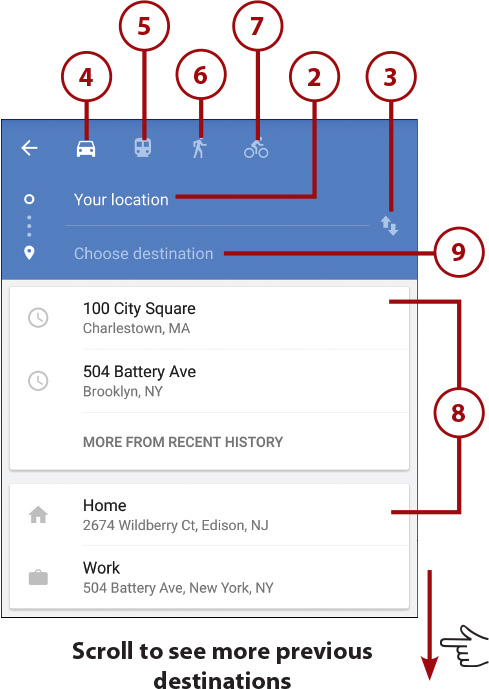
10. Tap to make changes to your route, including choosing alternative routes to travel and modifying options (such as avoiding toll roads). If you are happy with the route as is, skip to step 14.

11. Tap to decide whether you want to avoid highways, tolls, or ferries.
12. Tap to choose an alternative route. If you choose an alternative route, the screen automatically returns to the Map view.
13. Tap to return to the Map view.

14. Tap to start the navigation.

15. Tap to see and select alternative routes as they appear on the map.
16. Tap the Menu icon to mute the voice guidance, show traffic conditions, choose the Satellite view, and show the entire route alternatives.
17. Tap to speak commands such as “Show alternative route,” “How’s traffic ahead?” or “What time will I get there?”
18. Tap to cancel the route.

Configure Google Maps Settings
1. Swipe in from the left side of the screen.
2. Tap Settings.

3. Tap to edit your work and home addresses. Telling Maps your home and work addresses is important for Google Now to work more efficiently, but it also helps you quickly plan new routes to work and home.
4. Tap to enable or disable the capability for your phone to report its location. You can also choose the accuracy of your location by changing the mode.
5. Tap to improve your location accuracy if you think that your phone is not reporting it correctly.
6. Tap to see addresses you have looked up and received directions to. You can also delete items in this list.
7. Tap to set the distance unit of measure. You can either set it to Automatic so that Google Maps adjusts it based on where you are on the planet, or you can manually set it.
8. Tap to change the volume level for the voice that speaks the turn-by-turn directions, and choose whether you want to always start navigation using the Tilt Map. The Tilt Map presents the view as if you are looking ahead from behind the navigation arrow.
9. Tap to save your changes and return to the main Google Maps screen.
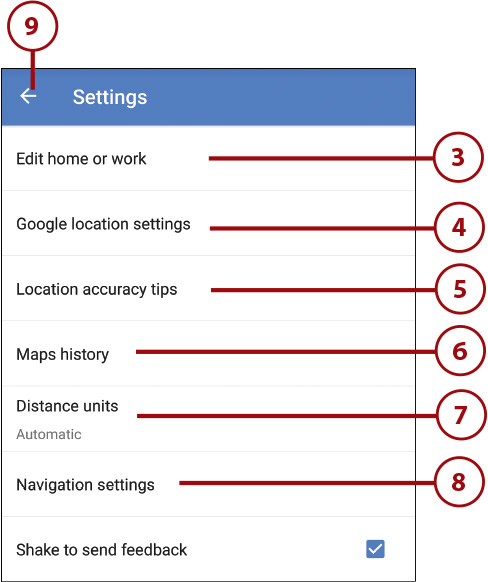
Use Offline Google Maps
Google Maps enables you to download small parts of the global map to your phone. This is useful if you are traveling and need an electronic map but cannot connect to a network to download it in real time.
1. Swipe in from the left of the screen.
2. Tap Your Places.

3. Scroll down to the bottom of the Your Places screen, and tap View All and Manage. If you have never saved an offline map, skip to step 4.

4. Tap Save a New Offline Map.

5. Pan around to find the area of the map you want to save offline.
6. Pinch to zoom out or unpinch to zoom in to the area of the map you want to save offline.
7. Tap Save when the area of the map fills the screen.

8. Type a name for the offline map and tap Save.

How Much Map Can I Take Offline?
When selecting the area of the map to take offline, you are limited to approximately 100Mb of map data. You don’t need to worry about the size of the data because if you have selected an area that is too large, Google Maps gives you a warning.


